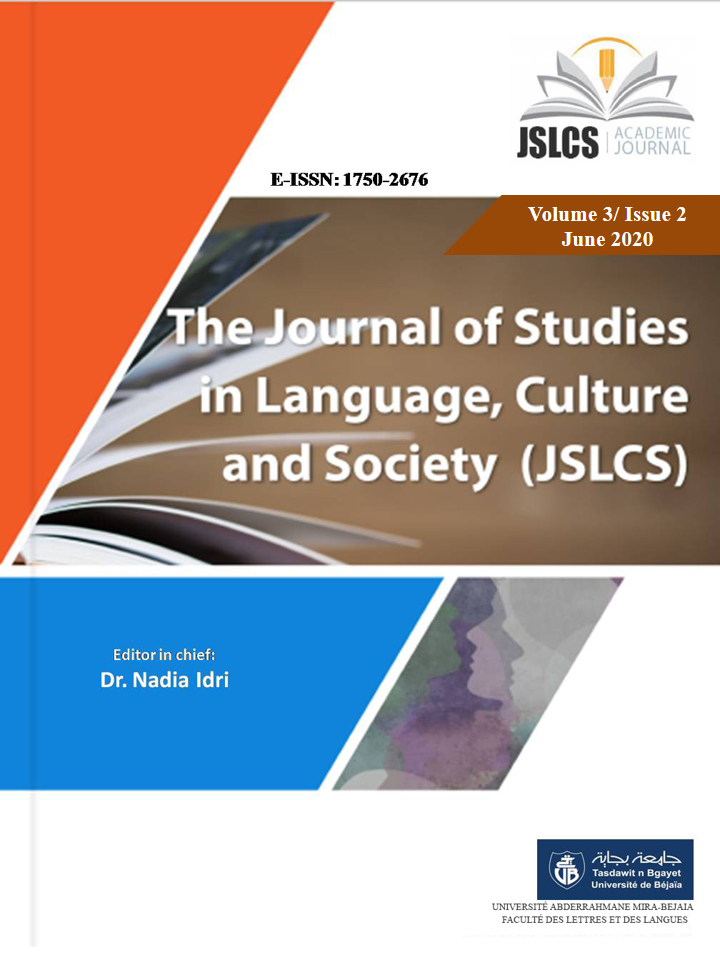Multilingual Code Switching In Contemporary Algerian Occassional Song
Keywords:
attitudes, code-switching, functions, occasional song, types of code-switchingAbstract
This study aims to explore and describe the phenomenon of code-switching in contemporary Algerian occasional song that deals with the Coronavirus event, basically to identify the types of code-switching found. Additionally, it investigates the attitudes of Algerian young people towards code-switching in these songs and how it is used as a device to achieve the communicative intents and serve certain functions in songs. To achieve these objectives, the authors relied on a mixed research method that includes twelve selected modern Algerian songs. The analysis was made based on Poplack theory and the six functions of code-switching proposed by Appel and Muysken. To this was added an audience study based on fieldwork in Tizi-Ouzou which involves data collection from survey questionnaires and individual online interviews. Three types of code-switching were discovered. They are extra/intra/ inter sentential code-switching. In addition, the findings show that code-switching in contemporary Algerian song is not a random switch from one code to another, but carries certain social functions that could provoke positive attitudes and behaviors for the target audience.
References
Angouri, J.O. (2010). Quantitative, qualitative or both ? combining methods in lin¬guistic research. In L. Litosseliti (Ed.), Research Methods in Linguistics (pp. 29-45). London, New York: Continuum.
Appel, R., & Muysken, P. (2006). Language contact and bilingualism. Amsterdam: University Press.
Babalola, E. T., & Taiwo, R. (2009). Code-switching in contemporary Nigerian hip-hop music. Itupale Online Journal of African Studies, 1, 1-26.
Benguedda, A. (2017). Sociolinguistic dimensions of code switching: The role of social factors in its occurrence in an Algerian context, Tlemcen Speech Community (Doctoral dissertation). Retrieved from http://dspace.univ- tlemcen.dz/handle/112/10243
Bentahila, A., & Davies, E.E. (2002). Language mixing in rai music: Localisation or globalisation? Language and Communication 22, 187-207. doi:10.1016/S02715309(01)00026-X
Blom, J.-P., & Gumperz, J. J. (1972). Social meaning in linguistic structure: Code-switching in Norway. In L. Wei (Ed.), The Bilingualism reader (pp. 111-136). London; New York: Routledge.
Cheng, L. & Butler, K. (1989). Code-switching: A natural phenomenon vs. language deficiency. World Englishes, 8(3), 293-309. doi.org/10.1111/j.1467-971X.1989.tb00670.x
Clyne, M. (1987). Constraints on code-switching: How universal are they? Linguistics, 25,739-764.
Codó, E. (2008). Interviews and questionnaires. In Li, Wei, M.G. Moyer (eds.), The Blackwell guide to research methods in bilingualism and multilingualism (pp.158-176). Oxford: Blackwell Publishing.
Crystal, D. (1987). The cambridge encyclopedia of language. Cambridge University Press: Cambridge.
Davies, E. E., & Bentahila, A. (2008a). Code switching as a poetic device: Examples from rai lyrics. Language & Communication, 28, 1-20. doi:10.1016/j.langcom.2006.10.001
Eastman, C. M. (1992). Codeswitching as an urban language contact phenomenon. Journal of Multilingual and Multicultural Development, 13, 1-17. doi:10.1080/01434632.1992.9994480
Gardner-Chloros, P. (1995). Code-switching in community, regional and national repertoires: The myth of the discreteness of linguistic systems. In L. Milroy, & P. Muysken (Eds.), One Speaker Two Languages: Cross-disciplinary Perspectives on Code-switching (pp. 68-90). Cambridge: Cambridge University Press.
Garrett, P. (2010). Attitudes to language. Cambridge: Cambridge University Press.
Garrett, P., Coupland, N., & Williams, A. (2003). Investigating Language Attitudes: Social Meanings of Dialect, Ethnicity and Performance. Cardiff: University of Wales.
Gumperz, J. (1982). Conversational code-switching. In J. Gumperz (Ed.), Discourse strategies. New York: Cambridge University Press.
Kouidri, F., (2009).Contact de langues et positionnement identitaire : La langue métissée du rap Algérien. Senyrgies Algérie, 8, 123-138. Retrieved from https://gerflint.fr/Base/Algérie8/Kouidri.pdf.
Milroy, L., Muysken P. (1995). (eds.) One speaker, two languages: Cross disciplinary perspectives on code-switching. Cambridge: Cambridge University Press.
Myers-Scotton, C. (1993a). Duelling languages: Grammatical structure in codeswitching. New York: Oxford University Press.
Myers-Scotton, C. (1993b). Social motivations for codeswitching: Evidence from Africa. Oxford: Oxford University Press.
Myers-Scotton, C. (1995). Social motivations for code-switching: Evidence from Africa. Oxford: Oxford University Press.
Myers-Scotton, C., & Carol. (1998). Codes and consequences: Choosing linguistic varieties. New York: Oxford University Press.
Poplack, S. (1978). Dialect acquisition among Puerto Rican bilinguals. Languages in Society, 7, 89-103. doi: 10.1017/S0047404500005340
Poplack, S. (1980). Sometimes I’ll start a sentence in English y termino en español: Toward a typology of code-switching. Linguistics, 18, 581-618. doi: 10.1515/ling.1980.18.7-8.581
Rosenberg, M. J., & Hovland, C. I. (1960). Cognitive, affective, and behavioral components of attitudes. In C. I. Hovland & M. J. Rosenberg (Eds.), Attitude organization and change: An analysis of consistency among attitude components (pp. 1–14). New Haven, CT: Yale University Press.
Sarkar, M., Winer, L., & Sarkar, K. (2005). The Proceedings of the 4th International Symposium on Bilingualism. Somerville, MA: Cascadilla Press. 2057-2074.
Schleef, E & Meyerhoff, M. (2010). Sociolinguistic methods for data collec¬tion and interpretation. In M. Meyerhoff & E. Schleef (Eds.), The Routledge Sociolinguistics Reader (pp. 1-17). London, New York: Routledge.








